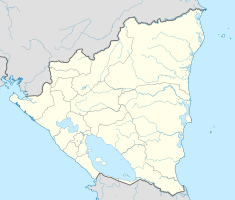Niquinohomo
| Niquinohomo | ||
|---|---|---|
|
Coordinates: 11 ° 54 ' N , 86 ° 5' W Niquinohomo on the map of Nicaragua
|
||
| Basic data | ||
| Country |
|
|
| Departments | Masaya | |
| Residents | 13,458 | |
| Detailed data | ||
| surface | 31.69 | |
| Population density | 425 inhabitants / km 2 | |
| height | 440 m | |
| Time zone | UTC −6 | |
| Augusto César Sandino's birthplace, photo from 1988 | ||
Niquinohomo is a town in the department of Masaya in Nicaragua . Augusto César Sandino was born in Niquinohomo .
education
The municipality has nine primary schools and three kindergartens. for the intermediate level, the Instituto Público Autónomo "Augusto César Sandino" and the Colegio "Academia de Santa María" give .
geography
Niquinohomo is located on a plateau in the southern half of Masaya. The distance to Niquinohomo Managua is 40 kilometers. The distance to Niquinohomo Masaya is five kilometers. In the order of expansion, Niquinohomo is the sixth municipality in the department of Masaya and consists of nine comarcas (districts) and three barrios as well as an urban center. The comarcas are: El Corozo , Los Huérfanos , Las Crucitas , Santa Rita , El Portillo , Justo Romero , Hoja Chigue and Los Pocitos . The barrios are: Tierra Blanca , Las Mercedes and El Guapinol .
history
In the Chorotega language, Niquinohomo is composed of "Nec" for warrior and "Nahome" for valley. From the beginning of the conquista , the names of the indigenous leaders Diriangén from Diriamba and Nequecheri , from Granada (Nicaragua) are known, who fought against Gil González Dávila in 1522 . In 1751, the Bishop of the Diocese of Nicaragua Lic. Fray Pedro Agustín visited Morel de Santa Cruz on a trip through his diocese, Niquinohomo. Niquinohomo consisted of six streets with 330 houses that were thatched with thatch, reed or brick. The bishop noticed that the bulls were running in the square opposite the church under construction. In 1856 cholera decimated the population of Niquinohomo. Until 1870 Niquinohomo belonged to the administrative district of Granada, which was the Partido Conservador . On February 19, 1870, under the government of General Fernando Guzmán from the Partido Conservador , the place was given the title Villa de la Victoria . In 1884 the municipality had an extension of 126 Caballerías (one Caballería corresponds to 65 Manzanas ; one Manzna corresponds to 0.698896 ha; 5,733 ha) and reached in the south to the Laguna de Masaya. By the 738th law of August 24, 1962, Niquinohomo was upgraded to Ciudad (city) with the publication in La Gaceta (Diario Oficial) on September 6, 1962 . On August 23, 2002, on the occasion of the 40th anniversary of the upgrading to Ciudad, in a special session of the National Assembly in the Church of Santa Ana with the participation of Enrique Bolaños Geyer , Niquinohomo was placed under monument protection as Patrimonio Histórico de la Nación . Niquinohomo and Providence are twin cities.
Healthcare
For health care there is the Centro de Salud "Augusto Cesar Sandino" as well as health posts in the comarcas: Los Pocitos , El Portillo and Las Crucitas .
Iglesia de Santa Ana
The church of Santa Ana was built in 1663, in the colonial baroque, from stones from the Laguna de Apoyo . During a renovation in 1945, there were a number of exhumations, some graves from the pre-colonial period were opened. On July 26th, the patron saint of Santa Ana is celebrated.
climate
In the tropical savannah, temperatures between 25 ° C and 27 ° C prevail all year round.
Culture
Niquinohomo has a public library with over 8000 volumes, and also supplies the towns of San Juan de Oriente , Catarina and Nandasmo . The birthplace of Sandino, was used as a library until recently and is being converted into the Museum del General de Hombres Libres .
Neighboring communities
The city borders on Masaya to the north, the Municipios Von Diría and la Paz de Carazo to the south, Catarina and San Juan de Oriente to the east, and Masatepe and Nandasmo to the west .
Sports
The most popular active sports are baseball and soccer. There are several clubs and the teams have different qualification levels. The respective women's teams from Niquinohomo have qualified. There are also basketball teams.
economy
Niquinohomo is a center of agriculture, especially cattle farming. Mainly staple grains (rice, corn), coffee, citrus fruits and flowers are grown. There are 19 agricultural cooperatives. The cattle herd are 1550 heads for meat and dairy production, which are marketed in the comarca. In Niquinohomo there are a number of small craft workshops in the joinery, cabinet making, shoemaker (shoes, belt), pottery, tailoring for tops, boleros, handicrafts, wooden spoons, whiskers. For the nearby market of Masaya there are gastronomic establishments: pulperías, taverns as well as bakeries and tailors.
Individual evidence
- ↑ El Nuevo Diario 27 de Noviembre de 2007 La Serpiente emplumada de Asososca ( Memento of the original from June 19, 2011 in the Internet Archive ) Info: The archive link was inserted automatically and has not yet been checked. Please check the original and archive link according to the instructions and then remove this notice.
- ^ New York Times September 2, 1986 NICARAGUA CLINIC AMERICAN-MADE

